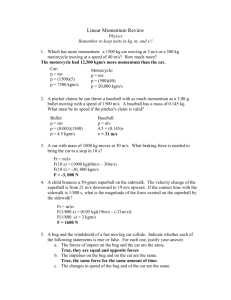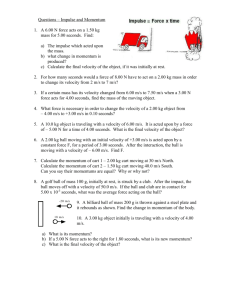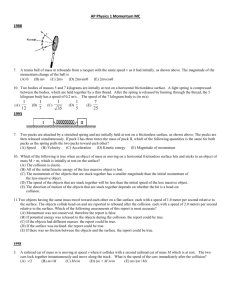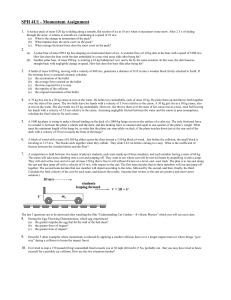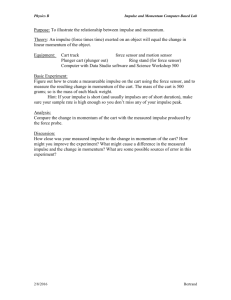Momentum Problems Solutions
advertisement
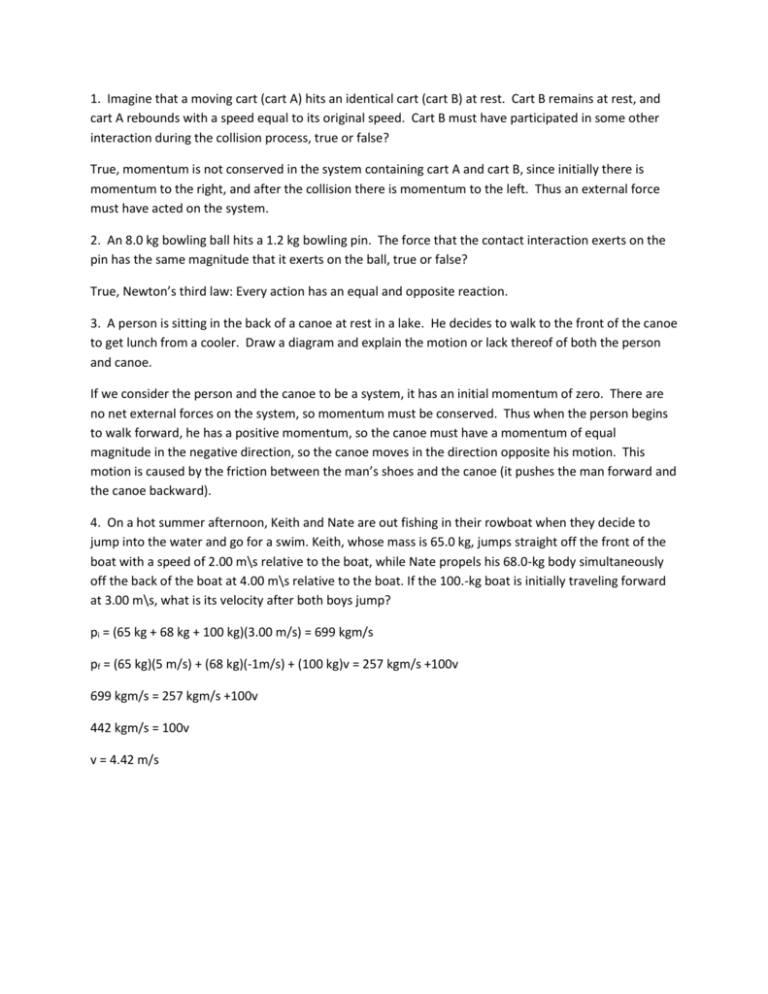
1. Imagine that a moving cart (cart A) hits an identical cart (cart B) at rest. Cart B remains at rest, and cart A rebounds with a speed equal to its original speed. Cart B must have participated in some other interaction during the collision process, true or false? True, momentum is not conserved in the system containing cart A and cart B, since initially there is momentum to the right, and after the collision there is momentum to the left. Thus an external force must have acted on the system. 2. An 8.0 kg bowling ball hits a 1.2 kg bowling pin. The force that the contact interaction exerts on the pin has the same magnitude that it exerts on the ball, true or false? True, Newton’s third law: Every action has an equal and opposite reaction. 3. A person is sitting in the back of a canoe at rest in a lake. He decides to walk to the front of the canoe to get lunch from a cooler. Draw a diagram and explain the motion or lack thereof of both the person and canoe. If we consider the person and the canoe to be a system, it has an initial momentum of zero. There are no net external forces on the system, so momentum must be conserved. Thus when the person begins to walk forward, he has a positive momentum, so the canoe must have a momentum of equal magnitude in the negative direction, so the canoe moves in the direction opposite his motion. This motion is caused by the friction between the man’s shoes and the canoe (it pushes the man forward and the canoe backward). 4. On a hot summer afternoon, Keith and Nate are out fishing in their rowboat when they decide to jump into the water and go for a swim. Keith, whose mass is 65.0 kg, jumps straight off the front of the boat with a speed of 2.00 m\s relative to the boat, while Nate propels his 68.0-kg body simultaneously off the back of the boat at 4.00 m\s relative to the boat. If the 100.-kg boat is initially traveling forward at 3.00 m\s, what is its velocity after both boys jump? pi = (65 kg + 68 kg + 100 kg)(3.00 m/s) = 699 kgm/s pf = (65 kg)(5 m/s) + (68 kg)(-1m/s) + (100 kg)v = 257 kgm/s +100v 699 kgm/s = 257 kgm/s +100v 442 kgm/s = 100v v = 4.42 m/s 5. A ball is dropped from the same height upon various flat surfaces. For the same collision time, impulses are smaller when the most bouncing takes place, true or false? False, the more bouncing that takes places, the greater the change in velocity (negative to positive), so the greater the change in momentum. Thus there must be a greater impulse since impulse equals change in momentum. 6. Consider the head-on collision between a lady bug and the windshield of a high speed bus. Which of the following statements are true? Select all that apply. a. The magnitude of the force encountered by the bug is greater than that of the bus. b. The magnitude of the impulse encountered by the bug is greater than that of the bus. c. The magnitude of the momentum change encountered by the bug is greater than that of the bus. d. The magnitude of the velocity change encountered by the bug is greater than that of the bus. e. The magnitude of the acceleration encountered by the bug is greater than that of the bus. Only d and e are true. In a collision we know that the magnitude of the force is equal because of Newton’s Third Law. The impulse is also the same because Impulse is force times time, and both the force and time are the same for the lady bug and the bus. The momentum change is also the same since change in momentum is equal to the impulse and the impulses are the same. The change in velocity is different because the less massive lady bug experiences a greater acceleration, thus a larger change in velocity. The acceleration is greater for the lady bug since it has less mass, thus less resistance to change in motion for the same applied force. 7. Challenge Problem: A 10 g bouncy ball is dropped from rest at a height of 5.0 m. It hits the floor, which it is in contact with for .002 s, and then returns to its original height. What is the force of impact due to the floor? If the ball rebounds to the same height, then its speed just before and just after hitting the floor must be the same. Now we must find the velocity just before hitting the floor using what we know from linear motion. 1 2 d = at2 + vit 1 2 5 = (10) t2 t = 1 sec vi + at = vf 0 + (-10)1 = vf = -10 m/s So the velocity just before the collision is -10 m/s and just after it is 10 m/s. Δp = mΔv = (.01 kg)(10 m/s – (-10 m/s)) = (.01 kg)(20 m/s) = .2 kgm/s Δp = Ft .2 kgm/s = F(.002 s) F = (.2 kgm/s) /(.002 s) = 100 N

